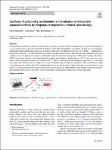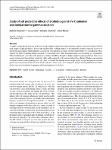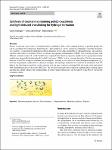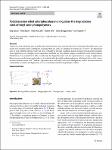Search
Author
- Carlos, Alegría (2)
- Carlos, Seara (2)
- David, Orden (2)
- Klaus, Bretterbauer (2)
- next >
Subject
Date issued
Has File(s)
- true (287)
Search Results
Recently, the loss of expertise in the nuclear- and radio-chemistry (NRC) is becoming an issue of concern, because of few engaging curricula and career prospects.
To counteract this trend, the Massive Open Online Course “Essential Radiochemistry for Society” has been developed with the intent of letting young students in scientific matters discover all the benefits of NRC to society and improving their awareness of these disciplines.
The MOOC development process as well as the feedbacks collected in the first MOOC editions are analyzed by highlighting strong points and weakness of the followed strategy. |
Common linear polymers are known to undergo phase changes at the glass-transition temperature (Tg) and the melting point (Tm). In recent years, it has also been shown that molecules with long aliphatic side chains can give rise to a backbone-independent melting phenomenon, known as nanophase separation. This effect describes the self-assembly — independent of the polymer backbone — of alkyl side chains into semi-crystalline nanostructures. This work presents optimized, gram scale synthesis routes for dodecyl and octadecyl acrylamide and their respective homopolymers. Differential scanning calorimetry (DSC) experiments detected a broad endothermal signal for poly(n-dodecyl acrylamide) at − 29 °C and a narrower, more intense signal for poly(n-octadecyl acrylamide) at 34 °C. These sign... |
A singlet oxygen production was monitored using a singlet oxygen sensor green chemical probe; reaction of chemical probe with singlet oxygen produces a fluorescent endoperoxide. Adding ethanol to the irradiated system resulted in decrease of the fluorescence signal, which indicates a decrease in concentration of singlet oxygen formed under UV-C irradiation. Thus, ethanol was likely to quench singlet oxygen in a system under study. This quenching did not occur with the use of methanol. When irradiating E. coli cells in the presence of ethanol and Rose Bengal for higher singlet oxygen production, there was a greater reduction in the radiation sensitivity of the cells compared to the system without Rose Bengal. |
Herein, we present a new route to synthesize poly(2-oxazoline)s (POx) with coumarin moieties as pendant groups that can be crosslinked by irradiation to form hydrogels. The synthesis of a novel coumarin-containing 2-oxazoline monomer, 2-[(4-methyl-7-coumarinyloxy)methyl]oxazoline is described in four steps and further its subsequent homo- and copolymerization with 2-ethyl-2-oxazoline (EtOx) via cationic ring-opening polymerization (CROP). The received polymers with different coumarin content (8, 4 and 2 mol%) were compared with a known copolymer synthesized via postpolymerization modification of partially hydrolyzed poly(2-ethyl-2-oxazoline) (PEtOx) with a coumarin derivative. The thermoresponsive behavior of the POx in aqueous solutions was investigated, showing a clear difference ... |
Nowadays, people are exposed to numerous man-made chemicals, many of which are ubiquitously present in our daily lives, and some of which can be hazardous to human health. Human biomonitoring plays an important role in exposure assessment, but complex exposure evaluation requires suitable tools. Therefore, routine analytical methods are needed to determine several biomarkers simultaneously. The aim of this study was to develop an analytical method for quantification and stability testing of 26 phenolic and acidic biomarkers of selected environmental pollutants (e.g., bisphenols, parabens, pesticide metabolites) in human urine. For this purpose, a solid-phase extraction coupled with gas chromatography and tandem mass spectrometry (SPE-GC/MS/MS) method was developed and validated. Aft... |
The heaviest elements can exclusively be produced in actinide-target based nuclear fusion reactions with intense heavy-ion beams. Ever more powerful accelerators deliver beams of continuously increasing intensity, which brings targets of current technology to their limits and beyond. We motivate efforts to produce targets with improved properties, which calls for a better understanding of targets produced by molecular plating, the current standard method. Complementary analytical methods will help shedding more light on their chemical and physical changes in the beam. Special emphasis is devoted to the aspect of the optimum target thickness and the choice of the backing material. |
Nanoparticles are emerging as a cutting-edge technology to improve crop agricultural input efficiency and reduce biotic and abiotic stresses. In viticulture, nanoparticles hold promise for the sustainable application of an elicitor (methyl jasmonate, MeJ), allowing a considerable dosage reduction. Herein, the influence of the foliar application of free MeJ (10 mM) and MeJ nanoformulation (ACP-MeJ, 1 mM MeJ) on Tempranillo grape amino acids content over two vintages (2019 and 2020) was evaluated. While both MeJ treatments provided a significant increase of the amino nitrogen and yeast assimilable nitrogen in the must in 2019, there were no significant differences on these parameters in 2020. |
Cement kiln dust (CKD) is a residue produced during the manufacture of cement that contains hazardous solid waste of high toxicity that affects the environment and public health. In this study, the possibility of using CKD as a filler in the plastic and rubber industry was studied. The effect of CKD concentration and gamma irradiation dose on the mechanical and physico-chemical properties of the composite containing waste polyethylene/devulcanized rubber/EPDM rubber (named blank) was investigated. Different concentrations of CKD, namely 10, 15, 20, and 30 phr (part per hundred part of composite), were used. The results indicated that this composite (blended with CKD) properties were improved. |
The synthesis of two dye-labeled azides via de-symmetrization of 2,6-bis(4-azidobenzylidene)-4-methylcyclohexanone (BAC-M) with a copper(I)-catalyzed alkyne-azide cycloaddition (CuAAC) using fluorescent dyes is reported. An alkyne functionalized dansyl derivative and an alkyne functionalized perylene diimide derivative were used as the dyes. The photo-physical properties of these dye dyads are described, and their performance in multi-photon grafting onto polyethylene glycol-based hydrogels is investigated. While the dansyl-conjugated BAC derivate is well suited for multi-photon grafting with lasers operating at 800 nm, the perylene diimide-bearing dye does not give the desired result. |
Vinyl esters and carbonates have recently been demonstrated to have considerably lower cytotoxicity than their more commonly used (meth)acrylate counterparts, inspiring their use in the 3D printing of biomaterials. However, the degradation rates of such synthetic photopolymers are slow, especially in the mild conditions present in many biological environments. Some applications, for example, tissue regeneration scaffolds and drug release, require considerably faster biodegradation. Furthermore, it is essential to be able to easily tune the degradation rate to fit the requirements for a range of applications. Herein we present the design and synthesis of hydrolytically degradable polyphosphazenes substituted with a vinyl carbonate functionalized amino acid. Thiolene copolymerization ... |










